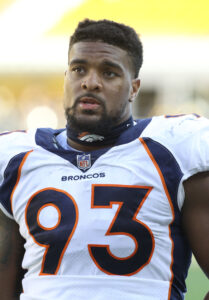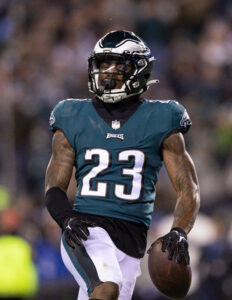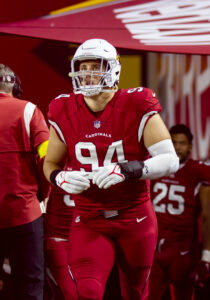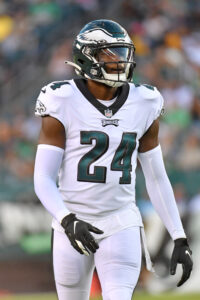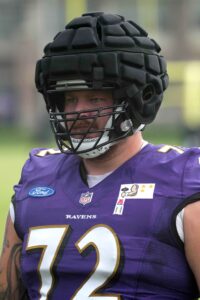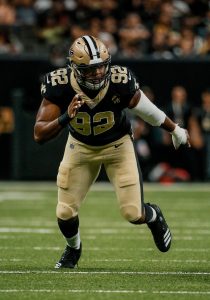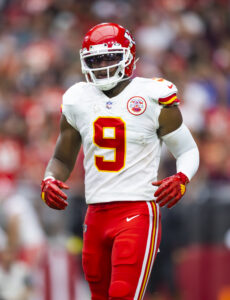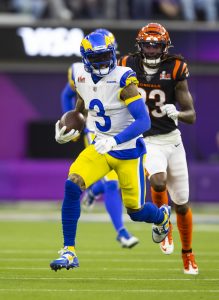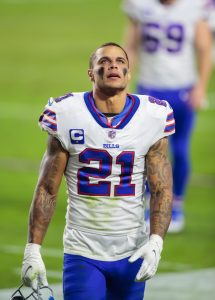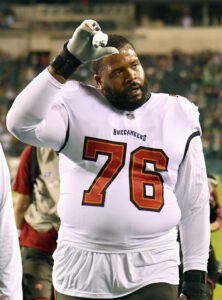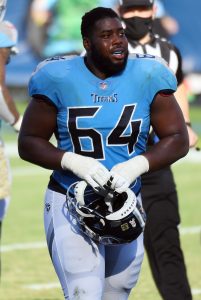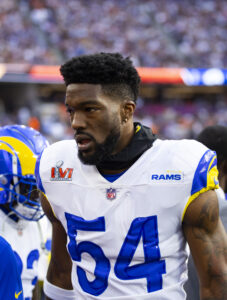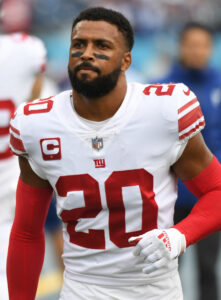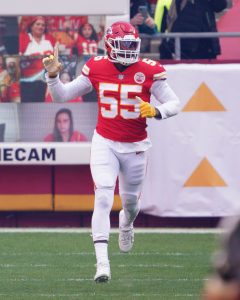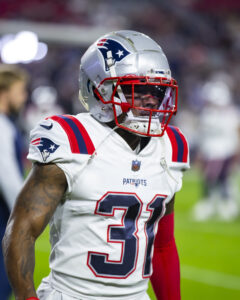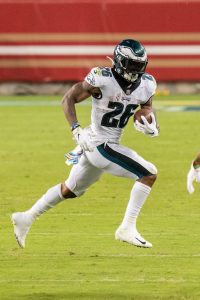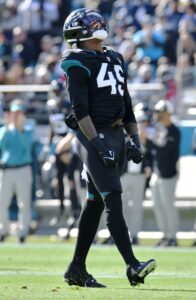5 Key Stories: 4/9/23 – 4/16/23
Attention continues to shift to the draft, but teams are still making moves on the free agent and trade fronts in advance of adding rookies to their rosters; one major off-the-field development took place recently, as well. Here is a quick recap of the past week’s top headlines:
- Harris Reaches Agreement To Purchase Commanders: The Dan Snyder era in Washington appears to be on the verge of coming to an end, with the Commanders owner reaching agreement on a sale which would see the group led by Josh Harris take over the Commanders. The $6.05 billion price would make this the second straight year in which the North American sports record was shattered in terms of sale price (with the Broncos going for $4.65 billion last summer). Harris is already a majority owner in the NBA, NHL and English Premier League. Now, he is poised to inherit a franchise which has been marred by poor play, numerous scandals and the need for a new stadium (unless today’s news regarding new bidder Brian Davis changes the situation). Investigations into workplace culture and financial impropriety centered on Snyder’s tenure at the helm, meanwhile, remain ongoing.
- Lions Deal Okudah To Falcons: The Lions moved on from the third overall pick in 2020, cornerback Jeff Okudah, in a trade with the Falcons. By receiving a fifth-round pick in return, the move marks a highly underwhelming end to Okudah’s tenure in Detroit, which included multiple injury problems. The 24-year-old showed some of the substantial potential he had coming out of college during the 2022 campaign, and should have a significant role in the Falcons’ new-look secondary. A strong season in 2023 could bode well for both team and player, though, with Okudah looking to play his way into a second contract in Atlanta or elsewhere.
- Ravens, Beckham Agree To Deal: All signs seemed to be pointing to Odell Beckham Jr. signing with the Jets, but the veteran wideout instead agreed to a one-year deal with the Ravens. Baltimore guaranteed $15MM for the three-time Pro Bowler, while incentives could push the maximum value of the pact to $18MM. That far outpaces what many believed Beckham, 30, would be able to sign for considering his missed time (including the entire 2022 season) due to multiple ACL injuries. The Ravens’ gamble comes as part of their retooling effort in the passing game, and it has led to the further expectation that quarterback Lamar Jackson (who helped recruit Beckham) will remain with the team in one form or another in 2023.
- White, Baker Request Trades: Two high-profile defenders – Buccaneers linebacker Devin White and Cardinals safety Budda Baker – have each asked to be traded amidst unproductive contract talks. White is under contract for one more season on the fifth-year option, but he is reportedly seeking one of the most lucrative deals at the position from Tampa or an acquiring team. Baker, meanwhile, let the Cardinals know in February that he was eyeing a new deal to make him the league’s highest-paid safety; two years remain on his 2020 extension, which doesn’t include any guaranteed money in 2023 or ’24. Both teams will look to navigate these developments as they continue contract talks in an attempt to avoid needing to part ways with either player.
- Carter Still Likely Top 10 Pick? Plenty of speculation has surrounded Jalen Carter in the build-up to the draft, considering his legal situation and underwhelming showing at Georgia’s pro day. Despite those factors, the defensive tackle is still expected to be a top 10 pick. The Bears and Eagles – who hold picks No. 9 and 10, respectively – have both shown interest in Carter and would be well-suited to add him to their defensive fronts. Other teams like Seattle, Detroit and Las Vegas have done their homework on him, which could create a competition to secure him early on Day 1. Despite a number of teams reportedly taking Carter off their draft boards altogether, he shouldn’t have to wait long to hear his name called next week.
NFL Draft Prospect Profile: Tennessee QB Hendon Hooker
We’ve already seen plenty of reports on the 2023 NFL Draft class’s top passing prospects. After the expected first-rounders (Alabama’s Bryce Young, Ohio State’s C.J. Stroud, Florida’s Anthony Richardson, and Kentucky’s Will Levis), nearly all other quarterback prospects aren’t expected to hear their names until Day 3 of the draft. The exception to that statement is Tennessee quarterback Hendon Hooker, considered one of the draft’s top passers who shouldn’t be available for long, if at all, after the first 31 picks. 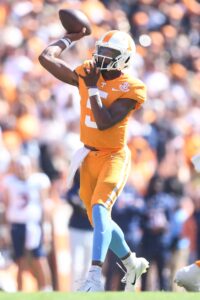
Hooker is one of the older quarterbacks in the draft, graduating from Dudley High School (NC) back in 2017. Considered a Top 247 player and the fifth-ranked dual-threat quarterback by 247Sports, Hooker initially committed to Virginia Tech a few weeks after receiving an offer and stuck with the Hokies despite some late flirting with Oregon.
In Blacksburg, Hooker competed with redshirt freshman Josh Jackson for the starting job at quarterback before redshirting, himself. In 2018, he would sit once again behind Kansas transfer Ryan Willis. The next year, Hooker would finally get an opportunity to start for the Hokies after a disappointing start to the season for Willis. With Hooker behind center, Virginia Tech rebounded to find their way to a bowl game thanks to Hooker’s 1,555 passing yards, 18 total touchdowns, and only two interceptions. Hooker returned as the starter in 2020 but only appeared in eight of 11 possible games. Overall, during his career with the Hokies, Hooker completed 63.1-percent of his passes for 2,894 yards, 22 touchdowns, and seven interceptions over 21 total games, adding 1,033 yards and 15 touchdowns on the ground.
Seeking greener pastures, Hooker transferred to Tennessee with many thinking he would back up Joe Milton, the Michigan transfer who was widely expected to take over after the departure of Jarrett Guarantano. An early injury to Milton, though, opened the door for Hooker to take the reins, and Hooker didn’t look back. A breakout season saw Hooker throw for 2,945 yards and 31 touchdowns to just three interceptions, adding 616 yards and five touchdowns on the ground. He utilized his extra COVID year of eligibility to return in 2022. Playing in two fewer games due to an ACL tear that ended his final year early, Hooker threw for 3,135 yards and 27 touchdowns to just two interceptions, adding 430 yards and five touchdowns on the ground.
The late-season ACL tear obviously hurts his draft stock, but maybe not quite as much as you might think. The 25-year-old was already likely expected to need some development after playing in Josh Heupel‘s extremely quarterback-friendly offense in Knoxville. His jump in success from Virginia Tech to Tennessee could be a result of the Volunteers’ offense that included mostly play action passes that had largely predetermined targets.
The convenient offense affected his ability to make reads which led to frequent checkdowns when his initial reads weren’t there. When he didn’t immediately check down, any hint of pressure would push him out of the pocket. While finding success on rollouts and scrambles, it did lead to a worrying 39 fumbles over his college career.
Additionally, his knee might not be the only concern health-wise. A potential heart condition was discovered when undergoing tests after a positive COVID test, according to Dennis Dodd of CBS Sports. The condition was determined to be a “false alarm” as a result of a procedure, but Hooker later suffered a convulsive episode that he blamed on medication from the heart procedure.
Looking past all that, Hooker was dominant at Tennessee. He took advantage of the quarterback-friendly offense for a masterfully efficient 58 touchdowns to five interceptions. He has a strong arm and touch that makes him a phenomenal deep ball passer. He didn’t rely on it in college, but he has an instinctive ability in the open field, utilizing agility, elusiveness, and toughness. Heupel lauded him as a hard worker and a strong leader, as well.
There’s a lot to like about Hooker’s long-term upside. His mental development over his collegiate career bodes well for his ability to attack the learning-curve he’ll face in the NFL. He boasts some strong tools, as well, that will come in handy when he does catch up to the professional game. As long as health is of no concern, there’s no reason that Hooker can’t develop into a starter at the NFL-level.
So who will take a chance on Hooker? As a bit of a project with recent health issues, it will likely be a team with a short-term or unproven situation at quarterback in 2023. Think the Commanders (Sam Howell), the Falcons (Desmond Ridder), the Colts (Gardner Minshew, Nick Foles), or the Texans (Davis Mills). The Ravens might even be a possibility with the current uncertainty surrounding Lamar Jackson.
While many expect him to fall to the second round, it wouldn’t be a total surprise to see a team trade up to the back of the first round as Baltimore did with Jackson in 2018. The extra fifth-year option could prove useful if Hooker sits for a year or two. Even if that’s not how it plays out, Hooker likely won’t sit around for long into Day 2. We’ll find out in just under two weeks from now.
5 Key Stories: 4/2/23 – 4/9/23
The countdown to the NFL draft continues, but a number of notable developments continue to take place around the league in the relatively quiet time between the initial waves of free agency and the arrival of the latest crop of rookies. Here is a quick recap of some of the top storylines from the past week:
- Titans Sign Simmons To Monster Deal: An extension for Titans defensive lineman Jeffery Simmons had been considered one of the team’s top priorities for the offseason, and it has now been taken care of. The two-time Pro Bowler inked a four-year, $94MM extension which will take effect starting in 2024. The pact places Simmons, 25, behind only Aaron Donald in terms of average annual value ($23.5MM) and slightly ahead of the Rams superstar in guarantees ($66MM). Tennessee has moved on from a number of veterans this offseason, but the ascending talent at the heart of their defensive line will be in place for years to come, while other DTs up for extensions will look to use his deal as a benchmark for their own contracts.
- Patriots Looked To Move Jones? Things didn’t go according to plan on offense for the Patriots in 2022, and the fallout from their much-maligned coaching setup continues. The relationship between quarterback Mac Jones and head coach Bill Belichick is not in a good place, and the Patriots reportedly shopped the 2021 first-rounder earlier this offseason. Jones, 24, repeatedly expressed frustration with the team’s underwhelming passing attack last year, something which no doubt contributed to his statistical regression compared to his rookie campaign. Belichick recently hinted at a training camp competition between the Alabama product and 2022 fourth-rounder Bailey Zappe, despite owner Robert Kraft‘s firm support of Jones. Potential developments for New England under center (which is not expected to include a Lamar Jackson pursuit) will certainly be worth watching.
- Jets To Host Beckham: The Jets continue to negotiate with the Packers on an Aaron Rodgers trade, something which is expected to produce a number of other moves on New York’s part. One of those would be a deal with free agent wideout Odell Beckham Jr., and the team will take a step closer to that on Monday by hosting him on an official visit. The 30-year-old sat out the entire 2022 season while rehabbing an ACL tear, and the list of serious suitors appears to have shrunk relatively recently. The Jets have long been connected to Beckham (especially given the assumption they will acquire Rodgers), and this sit-down will be his first official one. A deal sending him back to the Big Apple could soon follow.
- Panthers Favor Young With Top Pick? When the Panthers traded up to the No. 1 spot in this month’s draft, their intentions of selecting a quarterback were confirmed. It had originally seemed their preference was Ohio State’s C.J. Stroud, but signs are now pointing to Alabama product Bryce Young being the target. The latter has many fans inside Carolina’s organization, and is generally seen as the top passer in the 2023 class. His size is often named as a concern, though, especially within the context of the QB profile head coach Frank Reich tends to work with. Young, the 2021 Heisman winner, put up two highly productive seasons as the starter for the Crimson Tide and is, along with Stroud, seen as a known commodity compared to the other signal-callers in this class. Carolina will continue to evaluate their options, but Young hearing his name first on Day 1 would come as less of a surprise now than it previously would have.
- Cards’ Bidwill Facing Cheating, Misconduct Allegations: Cardinals owner Michael Bidwill is the subject of an arbitration claim filed by outgoing team executive Terry McDonough following alleged actions which took place in 2018. Specifically, McDonough claims he and then-head coach Steve Wilks were forced to illegally communicate with then-general manager Steve Keim during his suspension that year. The fallout from objecting to that plan, according to McDonough, has resulted in a number of actions taken against him by Bidwill which left him in a position of lower standing in the organization and off the radar for GM positions for other teams. The Cardinals have firmly denied the misconduct allegations, which also include claims of creating “an environment of fear for minority employees.” The matter will be resolved through the league’s arbitration policy.
Breakdown Of Top 2023 QB Draft Prospects
After last year’s draft, which saw only one quarterback taken in the first two rounds, this year’s draft class boasts a bit more top talent at the NFL’s signature position. The group’s superior personnel has already created a small amount of chaos atop the draft order with Carolina trading into the No. 1 overall pick. With three of the teams drafting at the top of the first round expected to have a need for a new quarterback, and several others having the option to trade up for one, there is a consensus that four quarterbacks should hear their names called on the night of April 27.
Teams interested in a new passer will have their choice between whoever is left of Alabama’s Bryce Young, Ohio State’s C.J. Stroud, Florida’s Anthony Richardson, and Kentucky’s Will Levis. Below, we’ll explore the benefits offered by each young quarterback and provide some reasoning as to why they may or may not hear their names called first.
Bryce Young
Not only was Young the best recruit in his state or at his position coming out of high school, the young athlete out of Mater Dei (California) was rated as the nation’s No. 1 overall recruit in 2020, according to 247sports.com. He committed to nearby USC with two years left of high school play but flipped his commitment to Alabama at the beginning of his senior year. 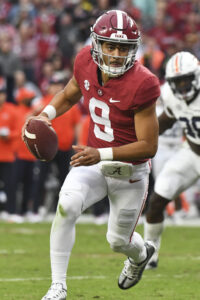
Young played sparingly as a freshman in Tuscaloosa, backing up junior starter Mac Jones. With Jones having departed for the NFL, Young took over the Crimson Tide offense as a sophomore. He took the college football world by storm in 2021, completing 66.91% of his passes for 4,872 yards and 47 touchdowns while only throwing seven interceptions. He took Alabama to the title game, falling to Georgia but stoking early perceptions of himself as a future No. 1 overall draft pick. In 2022, Young continued to impress despite the loss of several top receivers, two to the first two rounds of the previous year’s draft. He completed 64.47% of his passes for 3,328 yards, 32 touchdowns, and five interceptions.
Young came into college as the nation’s top dual-threat passer but never developed as much of a rusher at Alabama. Instead, he utilized his versatility to be an effective passer on the run. Young’s eyes and mind work fast through progressions and help him to anticipate throwing lanes at an elite level. He’s adapted to his smaller size in terms of vision, but he requires his lower body to make strong throws. Teams don’t seem to worry about his lack of size as much as his durability. In a league that’s already seen success from a smaller quarterback in Kyler Murray, Young is expected to become a starting quarterback at the NFL level before long.
C.J. Stroud
 Not far from Young in the southern California area, Stroud came out of the same class out of Rancho Cucamonga (California). Not quite as touted as Young, Stroud still boasted five stars as the nation’s second-best pro-style quarterback, according to 247. He made his decision late in the process but enrolled early shortly after committing to Ohio State.
Not far from Young in the southern California area, Stroud came out of the same class out of Rancho Cucamonga (California). Not quite as touted as Young, Stroud still boasted five stars as the nation’s second-best pro-style quarterback, according to 247. He made his decision late in the process but enrolled early shortly after committing to Ohio State.
Stroud also sat his true freshman season, redshirting behind starter Justin Fields. He was easily as productive as Young in their first years starting. In 2021, Stroud completed 71.88% of his passes for 4,435 yards and 44 touchdowns while only tossing six interceptions. Last year, Stroud, too, saw a bit of a drop-off in production, losing two receivers in the first round, but still impressed while completing 66.32% of his passes for 3,688 yards, 41 touchdowns, and six interceptions.
Stroud seems to be the most prototypical of the four options. His size, strength, and athleticism all signify a routine pro quarterback. His size gives him an ideally strong platform from which to throw and allows him to layer balls into short and intermediate levels over lineman and backers. The size does limit his agility, making him slow out of breaks and inaccurate when throwing on the run. His biggest strength, though, is his pure passing ability. He throws a strong, tight ball in a smooth motion, resulting in passes that receivers love to catch. His traditional quarterback makeup could be what makes him so attractive to a team like the Panthers at No. 1.
Anthony Richardson
Richardson is far and away the wild card of this group. A consensus four-star, dual-threat quarterback out of Eastside (Florida), Richardson stayed home in Gainesville for college after some back-and-forth on his commitment to the Gators. 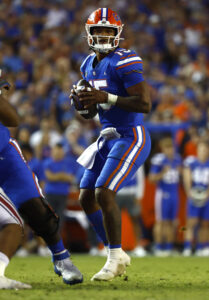
Richardson is the least experienced of the four top options at quarterback. Richardson redshirted behind Kyle Trask as a freshman and sat behind Emory Jones as a sophomore. It wasn’t until last year that Richardson found himself starting behind center. Unlike the unquestionable success of Young and Stroud, Richardson’s results were hardly as impressive. Last season, Richardson completed 53.82% of his passes for 2,529 yards and 17 touchdowns while throwing nine interceptions. He did display a stronger rushing ability than the above two, racking up 654 yards on 103 rushing attempts and tacking on nine scores with his legs. As a starter for the Gators, Richardson ended college with a 6-7 record.
Despite the seemingly mediocre production, Richardson has skyrocketed up draft boards as pundits have fallen in love with his potential. Richardson has a large frame, similar to Stroud, but boasts an athleticism that makes it much more dangerous. His size and burst make him reminiscent of a young Cam Newton with the ball in his hands. Richardson has a rocket for an arm, completing easy throws with only a flick of the wrist. The physical frame and abilities are there in a raw form, but much molding is necessary. He’s extremely inconsistent in his decision-making and accuracy, resulting in dangerous passes into a crowd and misses that never stand a chance of hitting their targets.
This is a common high-risk, high-reward situation with drafting quarterbacks. Richardson could develop into an All-Pro or flame out, unable to make the most of his abilities.
Will Levis
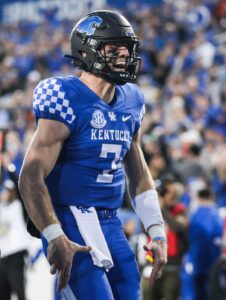 Levis is another curious prospect whose production doesn’t quite match his hype as a top draft pick. A three-star prospect leaving Xavier (Connecticut), Levis committed to Penn State as part of the 2018 recruiting class. After redshirting as a freshman, Levis sat for two years behind Sean Clifford before transferring to Kentucky.
Levis is another curious prospect whose production doesn’t quite match his hype as a top draft pick. A three-star prospect leaving Xavier (Connecticut), Levis committed to Penn State as part of the 2018 recruiting class. After redshirting as a freshman, Levis sat for two years behind Sean Clifford before transferring to Kentucky.
Levis took over as an immediate starter in Lexington and won 10 games for the Wildcats in 2021, completing 66.01% of his passes for 2,826 yards and 24 touchdowns while tossing 13 interceptions. Levis also displayed an ability to run the ball that year, producing 376 yards and nine touchdowns. When Wan’Dale Robinson and Josh Ali departed for the NFL, Levis’s production suffered as a result. In 2022, injuries and the loss of his top targets led to a down year in which he completed 65.37% of his passes for 2,406 yards, 19 touchdowns, and 10 interceptions, all without displaying the rushing ability of prior years.
Like Richardson, Levis boasts the size, arm strength, and athleticism that make him an extremely attractive prospect on paper. There are latent abilities available within Levis, but a lack of sound technique and procedure hold Levis back from his full potential. He can throw strong balls through tight windows but also struggles with consistent accuracy. He is physical and tough but needs that toughness when standing too long in the pocket. There are strong tools to utilize at the NFL level, but it will likely take time and a good coach preaching strong technique in order for Levis to become a strong starter at the next level. Teams want him to be the next Josh Allen, but he has a way to go in order to get there.
There we have it: two strong options who seem ready to start in Week 1 and two developmental projects who could turn into stars in the right system. Which team needs which quarterback the most? Tell us in the comments who you’d want your team to take a chance on.
5 Key Stories: 3/26/23 – 4/2/23
The first few waves of free agency have come and gone, but plenty of key storylines remain in place around the NFL. Here’s a quick recap of some of the top headlines from this past week:
- Packers, Jets Continuing Rodgers Negotiations: It is well known around the NFL that Aaron Rodgers wishes to continue his career with the Jets, and that the Packers are more than willing to move on from the four-time MVP. Trade talks between Green Bay and New York are now centered on the compensation (particularly in 2024 draft capital) which will be needed to finalize a swap. There is a growing sense that no first-round picks will be included in the package sent to the Packers, given the uncertainty surrounding Rodgers’ playing future beyond 2023. Most of the elements of this trade – including, quite possibly, the financial work which will be required for the Jets to absorb the 39-year-old’s contract – are said to be in place, though, so trade compensation likely represents the final hurdle to a deal being consummated.
- Jackson Goes Public With Trade Request: The saga surrounding Ravens quarterback Lamar Jackson has taken a number of turns recently, including his Twitter posts stating that he asked for a trade one month ago. Negotiations have remained ongoing for years now, but not much traction has been gained between player and team. The former MVP’s market has not heated up, as no serious suitors for an offer sheet or tag-and-trade have emerged to date. The issue of draft compensation, along with the matter of guarantees (although Jackson is reportedly not seeking a fully-guaranteed pact), has left the 26-year-old’s future in the air well into the offseason.
- Commanders Sale Approaching? Signs continue to point to the Dan Snyder era in Washington nearing an end. Two fully funded bids (from the groups led by Josh Harris and Steve Apostolopoulos) have been submitted, despite the fact that it is not known with certainty whether or not Snyder intends to sell. The latter’s recent actions, including reportedly moving himself and his family to England, however, have further fueled the belief that a sale will be finalized in the near future. In addition to Harris and Apostolopoulos, Houston Rockets owner Tilman Fertitta and an unnamed fourth bidder are in place as potential new Commanders owners.
- Hopkins Trade Market Heating Up? The 2023 free agent class of wideouts has, as expected, produced little in the way of big-money deals. One of the top trade candidates at the position, DeAndre Hopkins, is drawing interest from a number of teams, as the Cardinals continue to shop him. To no surprise, the 30-year-old is eyeing a contending team as his next home, but his contract represents a significant obstacle. Hopkins would likely sign an extension upon arrival with a new team to lower his 2023 cap hit ($29.99MM), but Arizona has remained firm in seeking a trade package including at least one second-round pick in return for the three-time All-Pro. Interested teams (including the Bills, Chiefs, Ravens and, perhaps less feasibly, the Patriots) are intent on having the Cardinals eat a portion of Hopkins’ remaining compensation to make a trade more manageable. The degree to which Arizona is willing to do so will no doubt go a long way in determining his playing future.
- Campbell Heading To Atlanta: After three years in Baltimore, six-time Pro Bowl defensive end Calais Campbell was a cap casualty of the Ravens this offseason, allowing him to head elsewhere on the open market. He did just that, inking a one-year deal with the Falcons which includes $7MM guaranteed and has a maximum value of $9MM. The 36-year-old proved he can still be an effective producer in the run and pass game in 2022, and will look for career sack No. 100 with an Atlanta team which has made a number of noteworthy additions so far in free agency. A strong year with his fourth career franchise will help the 2010s All-Decade member add further to his legacy.
2023 Top 50 NFL Free Agents
Super Bowl LVII provided the latest example of the value free agency can bring. The Chiefs revamped their receiving corps on last year’s market, while the Eagles acquired three defensive starters — including sack leader Haason Reddick. The Jaguars also used a March 2022 splurge to ignite their surprising surge to the divisional round.
Beginning with the legal tampering period, which starts at 3pm CT on Monday, and continuing with the official start to free agency (3pm Wednesday), the next several days represent a highlight on the NFL calendar. Which teams will change their 2023 outlooks for the better next week?
While the 2023 free agent class has absorbed its share of body blows and indeed lacks depth at certain spots, a few positions will bring waves of starter-level talent. Right tackle will invite some big-money decisions, and the safety and off-ball linebacker positions feature considerable depth. A few ascending talents and hidden gems appear in this class as well.
This list ranks free agents by earning potential. In terms of accomplishments, Bobby Wagner, Fletcher Cox and Lavonte David would lap most of the players included here. With each defender going into his age-33 season, however, the standouts’ ability to command big contracts is certainly not what it once was.
In terms of possible destinations, not every team is represented equally. Some teams will bring more needs and cap space into this year’s marketplace than others. With some help from Adam La Rose, here is this year’s PFR top 50 free agents list, along with potential landing spots for each player.
1. Orlando Brown Jr., T. Age in Week 1: 27
As the 49ers did two years ago with Trent Williams, the Chiefs will let Brown hit the market. This could end up benefiting the veteran tackle, who was offered a deal with an average annual value north of Williams’ tackle-record $23MM per year before last July’s franchise tag deadline. Citing insufficient guarantees, Brown turned it down. Kansas City’s offer did contain a bloated final year to bump up the AAV to $23.1MM, but will Brown – a quality left tackle but not a top-shelf option at the position – do as well this year? He will soon find out.
Brown has now made four Pro Bowls and carries positional versatility that would intrigue were he open to a return to right tackle, which by all accounts he is not. The 363-pound blocker can struggle against speed-rusher types, but he is set to be the rare accomplished left tackle in his prime to hit the market. The Chiefs sent a package including a first-round pick to the Ravens for Brown, whose bet on himself led to a $16.6MM tag and an open market. The bidding will run high, though it might not reach the places the Williams pursuit did in 2021.
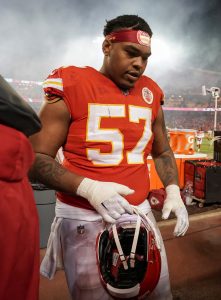 The Chiefs’ exclusive negotiating rights with Brown end March 13; they have had nearly two years to complete a deal. The market will determine if the league views the sixth-year blocker as an elite-level left tackle or merely a good one. Then again, bidding wars drive up the prices for O-linemen on the market. O-line salary records have fallen four times (Williams, Corey Linsley, Joe Thuney, Brandon Scherff) in free agency since 2021. This foray could give Brown the guaranteed money he seeks, and it puts the Chiefs at risk of seeing their two-year left tackle depart. The Ravens also passed on this payment back in 2021, in part because they already had Ronnie Stanley on the payroll.
The Chiefs’ exclusive negotiating rights with Brown end March 13; they have had nearly two years to complete a deal. The market will determine if the league views the sixth-year blocker as an elite-level left tackle or merely a good one. Then again, bidding wars drive up the prices for O-linemen on the market. O-line salary records have fallen four times (Williams, Corey Linsley, Joe Thuney, Brandon Scherff) in free agency since 2021. This foray could give Brown the guaranteed money he seeks, and it puts the Chiefs at risk of seeing their two-year left tackle depart. The Ravens also passed on this payment back in 2021, in part because they already had Ronnie Stanley on the payroll.
The defending champions have Brown and right tackle Andrew Wylie eligible for free agency; some of their leftover funds from the Tyreek Hill trade went to Brown’s tag. Although some among the Chiefs were frustrated Brown passed on last year’s offer, the team will be hurting at a premium position if he walks. Given the importance the blindside position carries, fewer teams are in need compared to right tackle. The Titans losing Taylor Lewan and continuing to clear cap space could point to a run at Brown, though the team has a few needs up front. The Jets likely have needs at both tackle spots. Would the Bears relocate Braxton Jones to the right side? Ryan Poles was with the Chiefs when they traded for Brown, and the Bears could outmuscle anyone for cap space.
Best fits: Titans, Chiefs, Commanders
2. Mike McGlinchey, T. Age in Week 1: 28
Teams in need of right tackles will participate in one of the more interesting markets in recent memory. Above-average-to-good offensive linemen do well in free agency annually, and this year will send three experienced right tackles in their prime to the market. A five-year starter in San Francisco and former top-10 pick, McGlinchey has a good case as the best of this lot. The five-year vet’s run-blocking craft eclipses his pass-protection chops exiting Year 5, but he will walk into a competitive market. The former Notre Dame left tackle should have a lucrative deal in place during next week’s legal tampering period.
Although mutual interest existed regarding a second 49ers-McGlinchey agreement, John Lynch acknowledged the only viable path for McGlinchey to stay in San Francisco would be his market underwhelming. That seems unlikely, so right tackle-seeking teams – and there are a handful – will jockey for the sixth-year veteran. McGlinchey turned 28 in January, making this his obvious window to cash in. He rated fifth in ESPN’s run block win rate stat last season, bouncing back from the quadriceps injury that ended his 2021 season.
There is no shortage of Kyle Shanahan– or Sean McVay-influenced schemes around the league. The Bears employ Luke Getsy as their play-caller; Getsy worked for Shanahan/McVay tree branch Matt LaFleur, and the Bears’ cap space dwarfs every other team’s. After fielding a shaky O-line (on a team full of substandard position groups), Chicago needs a better idea of Justin Fields’ trajectory. Outbidding the field for the top right tackle available is a good start. The Patriots want a right tackle – on a line without a big contract presently – and the Raiders might have a say here as well. In need at multiple O-line spots, Las Vegas will have cash as well if it passes on a big QB investment.
Best fits: Bears, Patriots, Raiders
3. Jawaan Taylor, T. Age in Week 1: 26
As expected, the Jaguars took Evan Engram off the market via the franchise tag. The tight end tag being $7MM cheaper than the $18.2MM offensive lineman tag always pointed Taylor toward free agency, and after never missing a start in four Duval County seasons, Taylor will be tough for the Jags to retain. They already drafted Walker Little in the 2021 second round, and no team that is currently paying a left tackle top-10 money (Cam Robinson is seventh) has a top-10 right tackle contract on the books. Taylor is expected to land at least a top-10 right tackle deal, with a $17MM-AAV figure being floated. That would place the former Florida Gator in the top five at the position, depending on how McGlinchey fares next week.
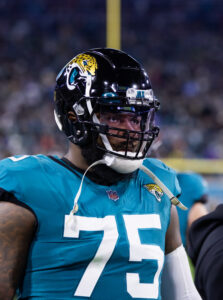 Taylor resembles the genre of player that usually populates the top of a position’s free agency market: a dependable performer who checks in below the top tier at his job. Taylor enjoyed his strongest year in his platform campaign. The former second-round pick dropped his hold count from 11 in 2021 to two in 2022. While PFF charged Taylor with five sacks allowed, Football Outsiders measured his blown-block rate at a career-low 1.3%. Offering a disparate skillset compared to McGlinchey, Taylor has fared better as a pass protector than in the run game. PFF slotted him as a top-10 pass protector among right tackles but viewed him as a dismal run-blocker.
Taylor resembles the genre of player that usually populates the top of a position’s free agency market: a dependable performer who checks in below the top tier at his job. Taylor enjoyed his strongest year in his platform campaign. The former second-round pick dropped his hold count from 11 in 2021 to two in 2022. While PFF charged Taylor with five sacks allowed, Football Outsiders measured his blown-block rate at a career-low 1.3%. Offering a disparate skillset compared to McGlinchey, Taylor has fared better as a pass protector than in the run game. PFF slotted him as a top-10 pass protector among right tackles but viewed him as a dismal run-blocker.
The Jags have presumably made Taylor an offer, but other teams will probably top it. The Dolphins gave Terron Armstead a five-year, $75MM deal in 2022 but have needed a right tackle ever since Ja’Wuan James’ 2019 exit. They were forced to start in-season pickup Brandon Shell for much of the year and have cleared more than $45MM in cap space over the past two days. The team just picked up Tua Tagovailoa‘s fifth-year option, and the league’s lone southpaw starting QB needs better blindside protection after a season in which he suffered at least two concussions. Overspending on O-linemen is not the Patriots’ M.O., but they have a need at right tackle and do not have big dollars devoted to quarterback or any position up front. New England is on the hunt for a right tackle upgrade, and the team’s 2021 free agency showed it would spend when it deemed expenditures necessary.
Best fits: Dolphins, Patriots, Jaguars
4. Jimmy Garoppolo, QB. Age in Week 1: 31
The quarterback market cleared up this week, seeing Geno Smith and Daniel Jones extended and Derek Carr’s lengthy street free agency stretch end with $70MM in practical guarantees. Garoppolo’s injury history will affect his value, but teams kind of make it a priority to staff this position. The former Super Bowl starter is in his prime and on the market for the first time. How high this market goes will depend on what the Raiders want and what Aaron Rodgers decides.
The 49ers’ 12-game win streak that included Brock Purdy’s stunning displays began with Garoppolo at the controls. Guiding San Francisco to four straight wins, Garoppolo was at or close to his best when he suffered a broken foot in Week 13. He sported a 7-0 TD-INT ratio during that win streak and closed the season 16th in QBR. He would have walked into a better market had the injury not occurred; the setback came after a string of health issues. He tore an ACL in 2018, missed 10 games in 2020 after an ankle sprain and was significantly limited by the end of the 2021 slate due to a three-injury season. Garoppolo’s March 2022 shoulder surgery hijacked his trade market.
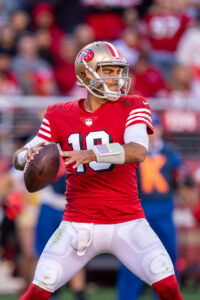 Ideally for Garoppolo, Rodgers returns to Green Bay or retires. While that is looking unlikelier by the day, it would put the Jets in a desperate position following Carr’s decision. The Raiders represent the other wild card. Garoppolo would slide into Josh McDaniels’ system seamlessly, given the parties’ three-plus years together in New England. The Raiders have operated a bit more stealthily compared to the Jets; they have been connected to Rodgers, Garoppolo and rolling with a rookie. Plan C here would be a tough sell given the presences of 30-year-old skill-position players Davante Adams and Darren Waller, but Las Vegas’ plans cloud Garoppolo’s market. If the Raiders pass and Rodgers chooses the Jets, Garoppolo’s earning power could drop.
Ideally for Garoppolo, Rodgers returns to Green Bay or retires. While that is looking unlikelier by the day, it would put the Jets in a desperate position following Carr’s decision. The Raiders represent the other wild card. Garoppolo would slide into Josh McDaniels’ system seamlessly, given the parties’ three-plus years together in New England. The Raiders have operated a bit more stealthily compared to the Jets; they have been connected to Rodgers, Garoppolo and rolling with a rookie. Plan C here would be a tough sell given the presences of 30-year-old skill-position players Davante Adams and Darren Waller, but Las Vegas’ plans cloud Garoppolo’s market. If the Raiders pass and Rodgers chooses the Jets, Garoppolo’s earning power could drop.
McDaniels not fancying a Garoppolo reunion opens the door for the Texans, who hired ex-49ers pass-game coordinator Bobby Slowik as OC, and others. Houston’s situation may not appeal to Garoppolo, but Slowik and Nick Caserio being in Houston make this connection too clear to ignore. The Buccaneers and Commanders are in win-now positions but are giving indications they do not want to spend much at QB. The Commanders were deep in talks for the then-49ers QB last year, however. Garoppolo will test those squads, along with the Falcons, who are entering Year 3 of the Terry Fontenot–Arthur Smith regime. The Panthers’ acquisition of the No. 1 pick likely takes them out of the running, and Carolina not being in the mix could also affect how high the Garoppolo price goes.
Bottom line, there should be enough teams interested in staffing their 2023 QB1 spots that the best free agent option should do OK no matter what happens with Rodgers.
Best fits: Raiders, Texans, Commanders
5. Jamel Dean, CB. Age in Week 1: 26
The Buccaneers retained Carlton Davis last year, but their dire cap situation should force a Dean departure. Dean’s age/performance combination should make him this year’s top cornerback available. With corner a position of need for many teams, the former third-round pick stands to do very well. Dean has only been a full-time starter in one season, however, seeing his defensive snap share jump from 67% in 2021 to 90% last season.
Excelling in press coverage, Dean played a major role for the 2020 Super Bowl champion Bucs iteration and overtook fellow free agent Sean Murphy-Bunting last year. Dean did perform better in 2021 compared to 2022, allowing no touchdowns and limiting QBs to a collective 50.0 passer rating; those numbers shot up to four and 86.0 last season. Still, PFF rated Dean as last year’s 10th-best corner. J.C. Jackson did not break into the top five among corners upon hitting the market last year; Dean should not be expected to do so, either. But many teams will be interested.
The Patriots have paid up for a corner previously, in Stephon Gilmore (2017), but Jonathan Jones – forced to primarily play a boundary role in 2022 – wants to re-sign and will be far cheaper than Dean. The Falcons need help opposite AJ Terrell and trail only the Bears in cap space. Although a Terrell payment is coming, it can be tabled to 2024 due to the fifth-year option. The Dolphins are clearing cap space and now have a corner need, with Byron Jones no longer with the team after his missed season.
Best fits: Dolphins, Falcons, Patriots
6. Jessie Bates, S. Age in Week 1: 26
Bates stands to be one of this free agency crop’s safest bets, combining extensive experience – the final two years as a pillar for a championship threat – with a host of prime years remaining. Beginning his career at 21, the Wake Forest product has started 79 games and anchored the Bengals’ secondary for most of his tenure. The Bengals did not tag Bates for a second time, passing on a $15.5MM price. With the team planning to let Bates test the market, it looks like the sixth-year defender will leave Cincinnati.
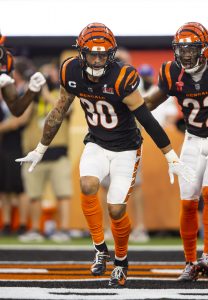 The Bengals and Bates went through two offseasons of negotiations, ending in the 2022 tag. The Bengals have some big payments to make at higher-profile positions. Safety does not qualify as such, but Bates has been a cornerstone in Lou Anarumo’s defense and will be handsomely rewarded. Bates finished as Pro Football Focus’ No. 1 overall safety in 2020 and, after a shakier 2021 in which he admitted his contract situation affected his play, Bates came through with impact plays in the postseason. He graded as a top-25 safety, via PFF, in 2022.
The Bengals and Bates went through two offseasons of negotiations, ending in the 2022 tag. The Bengals have some big payments to make at higher-profile positions. Safety does not qualify as such, but Bates has been a cornerstone in Lou Anarumo’s defense and will be handsomely rewarded. Bates finished as Pro Football Focus’ No. 1 overall safety in 2020 and, after a shakier 2021 in which he admitted his contract situation affected his play, Bates came through with impact plays in the postseason. He graded as a top-25 safety, via PFF, in 2022.
Safety is one of this year’s deeper positions in free agency. Of the top 10 safety contracts, however, only one went to a free agent (Marcus Williams in 2022). Bates should be expected to join the Ravens defender, who signed for $14MM per year. It will be interesting if he can climb into the top five at the position; Justin Simmons’ $15.25MM-AAV accord sits fifth. Bates should be expected to approach or eclipse that, though moving to the Derwin James–Minkah Fitzpatrick tier will be more difficult. Still, after the Bengals offered Bates less than $17MM guaranteed last summer, he should depart for more guaranteed money.
The Browns are interested in Bates, who will cost more than John Johnson cost Cleveland two years ago (three years, $33.75MM). Clear of the record-setting Matt Ryan dead-money hit, the Falcons have cash to spend and a Terry Fontenot–Arthur Smith regime entering Year 3. The Falcons need to make progress, and they do not have much in the way of talent or costs at safety. The team has not featured much here since the Keanu Neal–Ricardo Allen tandem splintered. Bates would be a way to remedy that.
Team fits: Falcons, Browns, Raiders
5 Key Stories: 2/26/23 – 3/5/23
The calendar has flipped over to March, which means the NFL Combine and the impending franchise tag deadline have driven most of the headlines in recent days. Here’s a quick recap of some of the top stories from the past week:
- Bears Open To Trading No. 1 Pick: Only twice this century has the No. 1 pick in the draft been traded, but that is a distinct possibility in 2023. The Bears are reportedly leaning toward a move down the board, something which GM Ryan Poles hinted at when giving incumbent quarterback Justin Fields a strong endorsement. Several QB-needy teams have top-10 picks, so a bidding war shouldn’t be difficult for the Bears to generate while fielding calls. Interestingly, Poles added that a trade involving the top selection could take place before free agency begins, which would be an unprecedented move.
- Saints Prepared To Sign Carr: Derek Carr figures to have several suitors as the top quarterback currently available, but New Orleans is reportedly “ready” to sign him right now. The Saints are in the market for an upgrade under center from their 2022 setup, and they pursued Deshaun Watson last offseason. They have plenty financial work remaining to become cap compliant, however, and will likely face competition from the likes of the Jets and Panthers to sign the 31-year-old. Carr could make his decision in the coming days, so his future – and that of the Saints at the QB position – could become clearer soon.
- Raiders To Tag Jacobs: The NFL’s leading rusher could have commanded a hefty payday on the open market, but he will remain in Vegas for at least one more season. Unless a long-term deal can be agreed upon with Josh Jacobs, the Raiders will tag him at a cost of $10.1MM. A multi-year deal appears to be each party’s preference, though Jacobs’ 2022 performance would no doubt drive up his contract demands; the two sides can negotiate a pact until mid-July assuming the tag gets used. The same holds true of Tony Pollard with the Cowboys.
- Wentz, Mariota Headline Veteran Cuts: Joining Carr in early quarterback free agency this past week were Carson Wentz of the Commanders and Marcus Mariota of the Falcons. Neither move came as a surprise, as the veterans lost their No. 1 positions midway through the 2022 season after being signed as bridge starters. Both Washington and Atlanta are likely to make additions under center this offseason, albeit with less expensive options to compete with Sam Howell and Desmond Ridder, respectively. Wentz and Mariota will look to catch on with a preferable situation as they attempt to rebuild their value. They are joined on the open market by other notable veterans such as wideout Kenny Golladay and running back Leonard Fournette.
- Jaguars To Tag Engram: After an up-and-down tenure with the Giants, Evan Engram enjoyed a career-year in 2022 with the Jaguars. He and the team have expressed their desire to continue their partnership, and the 28-year-old will remain in Duval County on at least the franchise tag (valued at $11.35MM). A long-term deal remains a strong possibility, and could take shape before the March 7 tag deadline. Failing that, Engram and the Jags could keep negotiating through July 15 as they look to retain several core members of last season’s playoff squad.
2023 Offensive/Defensive Coordinator Search Tracker
As the head coaching carousel spun for several weeks, many teams made coordinator changes as well. Teams seeking new head coaches are conducting OC and DC searches, and a handful of other teams that did not make HC changes are also searching for top assistants.
This is a big year for offensive coordinator hires, with nearly half the league making changes. Here are the teams searching for new OCs and DCs. As new searches emerge, they will be added to the list.
Updated 3-1-23 (3:31pm CT)
Offensive Coordinators
Arizona Cardinals
- Drew Petzing, quarterbacks coach (Browns): Hired
- Drew Terrell, wide receivers coach (Commanders): Interview requested
- Joel Thomas, running backs coach (Saints): Interview requested
- Troy Walters, wide receivers coach (Bengals): Interview requested
Baltimore Ravens (Out: Greg Roman)
- Brian Angelichio, tight ends coach (Vikings): Conducted second interview
- Eric Bieniemy, offensive coordinator (Chiefs): Interview being arranged
- Dave Canales, quarterbacks coach (Seahawks): Conducted second interview 2/6
- Bobby Engram, offensive coordinator (Wisconsin): Interviewed twice
- George Godsey, tight ends coach (Ravens): Interviewed
- Chad Hall, wide receivers coach (Bills): Interviewed 2/1
- Brian Johnson, quarterbacks coach (Eagles): Expected to interview?
- Byron Leftwich, former offensive coordinator (Buccaneers): Interviewed
- Todd Monken, offensive coordinator (Georgia): Hired
- Doug Nussmeier, former quarterbacks coach (Cowboys): Interviewed
- Chad O’Shea, wide receivers coach (Browns): Interviewed 1/23
- Justin Outten, offensive coordinator (Broncos): Conducted second interview 2/7
- Dan Pitcher, quarterbacks coach (Bengals): Received interest, extended by Bengals
- Frank Reich, former head coach (Colts): Mentioned as candidate
- Zac Robinson, quarterbacks coach (Rams): Interviewed 1/24
- James Urban, quarterbacks coach (Ravens): Interviewed
Carolina Panthers (Out: Ben McAdoo)
- Thomas Brown, tight ends coach, (Rams): Hired
- Jim Bob Cooter, passing-game coordinator (Jaguars): Interviewed
Dallas Cowboys (Out: Kellen Moore)
- Brian Angelichio, tight ends coach (Vikings): Interviewed 2/2
- Thomas Brown, tight ends coach (Rams): Interviewed
- Jeff Nixon, running backs coach (Panthers): Interviewed
- Brian Schottenheimer, offensive consultant (Cowboys): Hired
Denver Broncos (Out: Justin Outten)
- Ronald Curry, quarterbacks coach (Saints): Interviewed; to stay with Saints
- Joe Lombardi, former offensive coordinator (Chargers): Hired
Houston Texans (Out: Pep Hamilton)
- Nick Caley, tight ends coach (Patriots): Interviewed
- Jerrod Johnson, assistant quarterbacks coach (Vikings): Interviewed; named quarterbacks coach
- Kliff Kingsbury, former head coach (Cardinals): Interviewed 2/10
- Bobby Slowik, passing-game coordinator (49ers): Hired
- Troy Walters, wide receivers coach (Bengals): Interview requested
Indianapolis Colts (Out: Parks Frazier)
- Jim Bob Cooter, passing-game coordinator (Jaguars): Hired
- Tee Martin, wide receivers coach (Ravens): Interview requested
Kansas City Chiefs (Out: Eric Bieniemy)
- Matt Nagy, quarterbacks coach (Chiefs): Hired
Los Angeles Chargers (Out: Joe Lombardi)
- Joe Brady, quarterbacks coach (Bills): Interview requested
- Thomas Brown, tight ends coach (Rams): Interviewed 1/25
- Jerrod Johnson, assistant quarterbacks coach (Vikings): Interviewed 1/25
- Kellen Moore, former offensive coordinator (Cowboys): Hired
- Greg Olson, senior offensive assistant (Rams): Interviewed 1/24
- Frank Reich, former head coach (Colts): Mentioned as candidate
- Zac Robinson, quarterbacks coach (Rams): Interview requested
- Luke Steckel, tight ends coach (Titans): Interviewed 1/26
Los Angeles Rams (Out: Liam Coen)
- Marcus Brady, offensive consultant (Eagles): Interviewed
- Thomas Brown, tight ends coach (Rams): Mentioned as candidate
- Brian Johnson, quarterbacks coach (Eagles): Interviewed
- Mike LaFleur, former offensive coordinator (Jets): Hired
- Wes Phillips, offensive coordinator (Vikings): Declined interview request
- Frank Reich, former head coach (Colts): Mentioned as candidate
- Zac Robinson, quarterbacks coach (Rams): Mentioned as candidate
New York Jets (Out: Mike LaFleur)
- Darrell Bevell, quarterbacks coach (Dolphins): Declined interview request
- Marcus Brady, offensive consultant (Eagles): Interviewed
- Nick Caley, tight ends coach (Patriots): Interviewed 1/17
- Bill Callahan, offensive line coach (Browns): Declined interview request
- Nathaniel Hackett, former head coach (Broncos): Hired
- Brian Johnson, quarterbacks coach (Eagles): Interviewed
- Klint Kubiak, quarterbacks coach (Broncos): Interviewed 1/22
- Chad O’Shea, wide receivers coach (Browns): Interviewed 1/20
- Kevin Patullo, passing-game coordinator (Eagles): Interviewed
- Frank Reich, former head coach (Colts): Mentioned as candidate
Philadelphia Eagles (Out: Shane Steichen)
- Brian Johnson, quarterbacks coach (Eagles): Promoted
- Kevin Patullo, passing-game coordinator (Eagles): Mentioned as candidate
- Nate Scheelhaase, offensive coordinator (Iowa State): Interviewed
Tampa Bay Buccaneers (Out: Byron Leftwich)
- Thomas Brown, tight ends coach (Rams): To conduct second interview 2/15
- Dave Canales, quarterbacks coach (Seahawks): Hired
- Jim Bob Cooter, passing-game coordinator (Jaguars): Interviewed 1/26
- Ronald Curry, passing game coordinator/quarterbacks coach (Saints): Interviewed 1/31
- Pep Hamilton, offensive coordinator (Texans): Declined interview request
- Klint Kubiak, quarterbacks coach (Broncos): Interviewed 1/26
- Keenan McCardell, wide receivers coach (Vikings): Interviewed 1/26
- Todd Monken, offensive coordinator (Georgia): Interviewed 1/31
- Scottie Montgomery, running backs coach (Lions): Interviewed 2/13
- Kellen Moore, former offensive coordinator (Cowboys): mentioned as candidate
- Dan Pitcher, quarterbacks coach (Bengals): Interviewed 1/27; conducted second interview with Bucs but will remain with Bengals
- Shea Tierney, quarterbacks coach (Giants): Interviewed 1/31
Tennessee Titans (Out: Todd Downing)
- Eric Bieniemy, offensive coordinator (Chiefs): Interview requested
- Tim Kelly, passing-game coordinator (Titans): Hired
- Charles London, quarterbacks coach (Falcons): To interview
- Matt Nagy, quarterbacks coach (Chiefs): Interview requested
Washington Commanders (Out: Scott Turner)
- Darrell Bevell, quarterbacks coach (Dolphins): Declined interview request
- Eric Bieniemy, offensive coordinator (Chiefs): Hired
- Thomas Brown, tight ends coach (Rams): Interviewed 1/24
- Jim Caldwell, former head coach (Lions): Declined interview request
- Charles London, quarterbacks coach (Falcons): Interview requested
- Anthony Lynn, assistant head coach/running backs coach (49ers): Interviewed 2/1
- Greg Roman, former offensive coordinator (Ravens): Interviewed 2/14
- Pat Shurmur, former offensive coordinator (Broncos): Interviewed; fallback option?
- Eric Studesville, running backs coach (Dolphins): Interviewed 1/23
- Ken Zampese, quarterbacks coach (Commanders): Interviewed 1/18
Defensive Coordinators
Arizona Cardinals (Out: Vance Joseph)
- Dave Borgonzi, linebackers coach (Bears): Interviewed 2/17
- DeMarcus Covington, defensive line coach (Patriots): Interview requested
- Nick Rallis, linebackers coach (Eagles): Hired
Atlanta Falcons (Out: Dean Pees)
- Ejiro Evero, former defensive coordinator (Broncos): Interview blocked
- Vic Fangio, former head coach (Broncos): Interviewed
- Brian Flores, linebackers coach (Steelers): Interview requested; mutual interest?
- Jerry Gray, defensive backs coach (Packers): Interview requested
- Al Holcomb, interim defensive coordinator (Panthers): Interview requested
- Ryan Nielsen, co-defensive coordinator (Saints): Hired
Buffalo Bills (Out: Leslie Frazier)
- John Butler, defensive backs coach (Bills): Mentioned as candidate
Carolina Panthers (Out: Al Holcomb)
- Ejiro Evero, former defensive coordinator (Broncos): Hired
- Vic Fangio, former head coach (Broncos): Interviewed
- Marquand Manuel, safeties coach (Jets): Interviewed
- Kris Richard, co-defensive coordinator (Saints): Interviewed
Denver Broncos
- Sean Desai, defensive assistant (Seahawks): Interviewed 2/7
- Ejiro Evero, former defensive coordinator (Broncos): Released from contract
- Brian Flores, linebackers coach (Steelers): Interview cancelled
- Vance Joseph, defensive coordinator (Cardinals): Hired
- Matt Patricia, senior football advisor (Patriots): Interviewed 2/22
- Christian Parker, defensive backs coach (Broncos): Interviewed
- Kris Richard, former co-defensive coordinator (Saints): Interviewed
- Rex Ryan, former head coach (Bills): Conducted second interview 2/18; considered favorite?
- Mike Zimmer, former head coach (Vikings): Mentioned as candidate; interviewed for separate Broncos job
Houston Texans
- Matt Burke, defensive line coach (Cardinals): Hired
- Chris Harris, defensive backs coach (Commanders): Interview requested
- Kris Kocurek, defensive line coach (49ers): Mentioned as candidate; expected to remain with 49ers
- Marquand Manuel, safeties coach (Jets): Interviewed 2/7
- Cory Undlin, passing-game specialist/secondary coach (49ers): Mentioned as candidate
Los Angeles Chargers (Out: Renaldo Hill)
- Derrick Ansley, defensive backs coach (Chargers): Promoted
- Doug Belk, defensive coordinator (Houston): Interviewed
- DeMarcus Covington, defensive line coach (Patriots): Interviewed
Miami Dolphins (Out: Josh Boyer)
- Anthony Campanile, linebackers coach (Dolphins): Interviewed 1/27
- Sean Desai, defensive assistant (Seahawks): Interviewed 1/25
- Vic Fangio, former head coach (Broncos): Hired
- Kris Richard, co-defensive coordinator (Saints): Interviewed 1/26
Minnesota Vikings (Out: Ed Donatell)
- Sean Desai, defensive assistant (Seahawks): Interviewed 1/24; to withdraw from search
- Ejiro Evero, former defensive coordinator (Broncos): Expected to interview
- Brian Flores, linebackers coach (Steelers): Hired
- Ryan Nielsen, co-defensive coordinator (Saints): Interview requested
- Mike Pettine, defensive assistant (Vikings): Interviewed 1/25
New Orleans Saints (Out: Ryan Nielsen, Kris Richard)
- Joe Woods, former defensive coordinator (Browns): Hired
Philadelphia Eagles (Out: Jonathan Gannon)
- Sean Desai, defensive assistant (Seahawks): Hired
- Vance Joseph, defensive coordinator (Cardinals): Interviewed 2/21-2/22
- Jesse Minter, defensive coordinator (Michigan): Interviewed
- Glenn Schumann, co-defensive coordinator (Georgia): Interviewed
- Chris Shula, defensive backs coach (Rams): Interviewed
- Jim Leonhard, defensive coordinator (Wisconsin): Interviewed
- Dennard Wilson, defensive backs coach (Eagles): Mentioned as candidate
San Francisco 49ers (Out: DeMeco Ryans)
- Vic Fangio, former head coach (Broncos): On radar
- Chris Harris, defensive backs coach (Commanders): Interviewed 1/31
- Kris Kocurek, defensive line coach (49ers): On radar
- Steve Wilks, former interim head coach (Panthers): Hired
Community Tailgate: Lamar Jackson
Ozzie Newsome’s final draft as Ravens general manager in 2018 saw the team secure a succession plan for Joe Flacco at the quarterback position. With the Super Bowl XLVII MVP aging and approaching an important financial point in his contract, Lamar Jackson was selected to one day take over the reins of a transitioning offense.
That time came midway through Jackson’s rookie season, when the Louisville product took over for an injured Flacco. He helped lead the Ravens to a 6-1 record and a playoff berth, cementing his status as the starter moving forward. The 2019 season saw Jackson deliver one of the most unique and historic performances in NFL history, which culminated in the league’s second ever unanimous MVP vote. Expectations have been through the roof ever since, but the situation between Jackson and the Ravens has soured recently with contract talks netting little progress over the past two years. 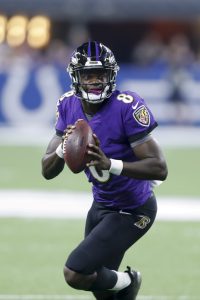
The 26-year-old was thought to be next in line for a mega-extension similar to the ones signed by Patrick Mahomes and 2018 classmate Josh Allen. The Ravens have been prepared to pay Jackson in a similar fashion to those two in terms of annual compensation in the neighborhood of $45MM per season. As time wore on without much traction being gained during negotiations, though, the events of last offseason marked an important turning point.
After being the subject of a bidding war, Deshaun Watson was ultimately traded to the Browns and signed to a five-year, $230MM deal. The surprise from Cleveland’s willingness to part with three first-round picks for him was surpassed only by the fully guaranteed nature of his pact. Many around the league – including Ravens owner Steve Bisciotti – lamented the historic investment the Browns made in Watson, acutely aware of how it would likely affect Jackson’s leverage in extension talks.
The previous season had seen Baltimore find itself atop the AFC standings before a reaching a tipping point on the injury front. That included Jackson missing time due to injury for the first time in his career. He was sidelined for the final five games of the year, and the Ravens narrowly missed the playoffs while struggling mightily on offense. Reports then emerged during the summer of 2022 that the two-time Pro Bowler turned down an offer including $133MM in guaranteed money.
That figure would have ranked second in the league, but nowhere near the level of Watson’s deal. New contracts signed by Russell Wilson ($124MM fully guaranteed) and Kyler Murray ($103MM) suggested teams were willing to ignore the Watson accord in terms of precedent on the guarantee front, something GM Eric DeCosta and the Ravens’ front office is holding firm on. Jackson made it clear he would pause negotiations during the 2022 season, one which was expected to provide clarity on his financial future.
Playing on the fifth-year option, Jackson and the Ravens instead followed a similar script this year. The former Heisman winner suffered a knee injury in Week 13, something which was not initially expected to cost him the remainder of the season. That did end up being the case, however, and much was made about his absence extending into the team’s postseason loss. Jackson’s decision to take to social media to elaborate on the extent of his PCL sprain, and later to issue a thinly-veiled directive to the team regarding his impending free agency has likewise not sat well.
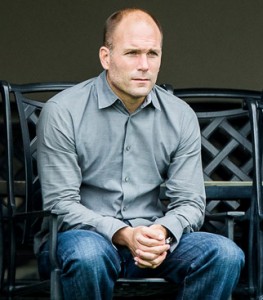 Having missed 10 of the past 22 games, injuries have become a talking point with so much at stake in contract talks. That figure could give the Ravens (or any other interested team) perceived leverage, but Jackson has plenty as well. The Ravens are 46-19 in his starts, and 4-9 without him since 2019. The team’s offense has averaged 10 fewer points per game without Jackson during that span compared to the games in which he does play.
Having missed 10 of the past 22 games, injuries have become a talking point with so much at stake in contract talks. That figure could give the Ravens (or any other interested team) perceived leverage, but Jackson has plenty as well. The Ravens are 46-19 in his starts, and 4-9 without him since 2019. The team’s offense has averaged 10 fewer points per game without Jackson during that span compared to the games in which he does play.
A new offensive coordinator in Todd Monken is expected to produce schematic changes compared to Greg Roman, the OC during each of Jackson’s four full seasons as a starter. Regardless of what takes place on that front, the Ravens’ pass-catching corps (which lacks established playmakers outside of tight end Mark Andrews) will be a key area of focus. Additions – such as a long-term replacement for Marquise Brown, whose trade request was quietly granted last spring – will be hard to come by when Jackson takes up a substantially higher portion of the Ravens’ cap, either through a mega-deal or a one-year charge brought on by the franchise tag.
The difficulty in acquiring and retaining pass-catchers increasingly became a point of contention after Flacco turned his 2012 playoff success into a franchise-record extension. Trepidation on the team’s part in terms of looking to avoid a repeat of that scenario would be understandable up to a point, as the Ravens look to keep Jackson in the fold while not compromising an otherwise strong roster.
With the franchise tag being all-but certain in Jackson’s case, this saga could continue for months to come. An offer sheet or tag-and-trade could come into play, depending on which tag the Ravens use and Jackson’s perceived market around the league. Whether he signs his tag is another matter altogether, and sitting out the offseason could lead to a holdout situation similar to Le’Veon Bell in 2018. The then-Steeler skipped the entire campaign, forfeiting millions in compensation (albeit far less than what Jackson would be giving up if he followed suit). Bell still landed a big-ticket deal from the Jets in 2019, so the tactic could prove useful if a repeat were to be attempted.
In the summer, PFR’s readers were split on how they felt this situation would unfold. No option is off the table at this point, from a franchise-record deal to the league’s first ever trade involving an MVP under the age of 30. How do you see things playing out? Which side will concede during negotiations? Where will Jackson play in 2023 and beyond? Have your say in the comments section.
5 Key Stories: 2/19/23 – 2/26/23
With free agency not far away, the coordinator hiring cycle has begun to wind down as teams look to make financial moves to become cap compliant and free up flexibility. In case you missed any of this past week’s top headlines, here’s a quick recap:
- Giants Continuing Jones, Barkley Talks: All teams have important decisions to make in the next few days, but the Giants face the dilemma of keeping quarterback Daniel Jones and running back Saquon Barkley on the roster for at least one more year. They have resumed contract negotiations with Jones, in the wake of reports that he is seeking north of $40MM (perhaps as much as $45MM) per season. New York is trying to finalize a deal at a more affordable number, knowing that the franchise tag deadline (March 7) is approaching. That one-year option remains for Barkley in particular, though the team’s intention remains multi-years deals for both. Progress will need to be made soon on at least one front if they wish to avoid either player hitting the open market.
- Rams Moving On From Wagner: All-Pro linebacker Bobby Wagner chose to sign with his hometown team on a five-year deal last offseason, but that contract resulted in only a one-year stint there. The Rams and Wagner will mutually part ways when the new league year begins, and he will likely once again have a robust market for his services. The 32-year-old remained highly productive in 2022, but will turn his attention to signing with a contender. In the wake of that news, it has since come out that star corner Jalen Ramsey is expected to be traded as the Rams reset financially.
- Chiefs Promote Nagy To OC: The departure of Eric Bieniemy left a vacancy at the offensive coordinator spot for the Super Bowl champions. The Chiefs made the expected move of promoting from within, naming Matt Nagy as their new OC. The ex-Bears head coach is now in his second stint under that title in Kansas City, though it does not include play-calling duties on a full-time basis. Nagy worked as quarterbacks coach in 2022, and has experience working not only with HC Andy Reid but QB Patrick Mahomes as well. The decision will give the Chiefs continuity as they look to lengthen their recent run of success.
- Titans Shed Significant Salary: Cost-cutting season is in full swing, and the Titans made several notable moves by releasing wideout Robert Woods, linebacker Zach Cunningham, left tackle Taylor Lewan and kicker Randy Bullock within a matter of hours. The slew of cuts freed up more than $35MM in cap space, but Tennessee still sits outside the top-10 in the league in terms of financial wiggle room. In Lewan’s case, retirement could very well be the next step, but the other three will now get a head start on free agency. The Titans will have a number of replacements to find in the coming weeks and months in their bid to rebound from a disappointing 2022 campaign.
- Broncos Reunite With Joseph: The Broncos have plenty of new faces on their coaching staff, including Sean Payton at the helm. However, their defense will have some familiarity under Vance Joseph, who was hired to come back to the Mile High City after his HC stint there ended in 2018. Since then, he had led Arizona’s defense and recently been let go by the Cardinals’ new staff. The 50-year-old won out over a few other notable candidates, including Rex Ryan, Matt Patricia and Sean Desai. He will aim to continue Denver’s success on defense in 2022, while Payton and Co. attempt to revive the team’s offense.

